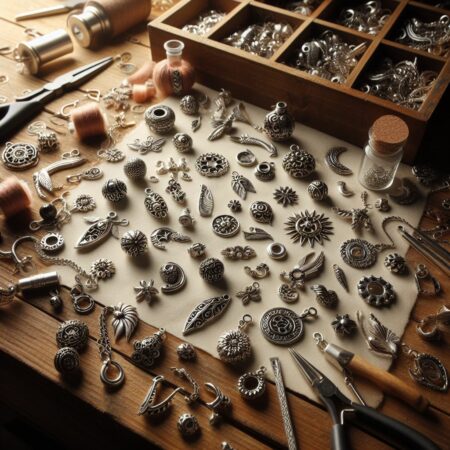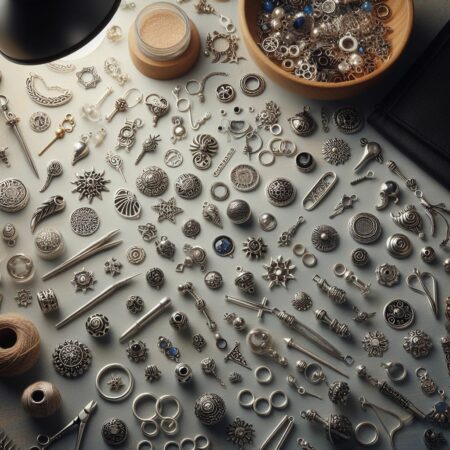Are you interested in working with jewelry metals? Do you gradually like to craft fine jewelry at home as you collect the right jewelry tools and expertise, like beading strings on a wire? If so, you’re in the right time and place to learn more about jewelry metals, including jewelry metals that don’t tarnish.
The Market for Jewelry Metals
Metals are bought and sold as commodities on exchange markets in addition to being purchased as raw materials for jewelers. As a result, precious metals prices fluctuate daily, similar to the price of gasoline or a stock. (In reality, when the price of oil rises, gold and silver prices rise as well, as more individuals shift their investments away from oil and into other raw commodities.) Therefore, when ordering precious metals from a provider, the price listed in the catalog is only a guideline. The materials are usually priced on the day your item is sent.
Buying Jewelry Metals for the First Time?
Nonferrous metals can be purchased in various forms, including sheet, wire, tubing, and grain, to make it easier to make jewelry. Many different versions of these popular metal forms are available from various sources. Tubing and wire, for example, come in various shapes and sizes, including round, half-round, square, and rectangular. Purchasing metal in pre-formed shapes saves time and energy, and the variety of shapes available might inspire your creativity.
Measuring Wires and Sheets
The American Wire Gauge (AWG) or Brown and Sharpe (B&S) measurement systems commonly measure wire and sheets. Metals are classified using this approach based on their gauge, related to their thickness. The gauge number is inversely proportional to the thickness of the metal; the more significant the gauge number, the thinner the metal. Because each metal supplier somewhat alters the measurements of its gauges, the Brown & Sharpe system is best utilized as a reference. Purchasing your metal from the same source can help you maintain consistency in your measurements. The millimeter measurement for typical metal gauges can be found in the table below.
Ethics in the Mining Industry
All metals are mined, to begin with. Then, deep holes are dug to dig the ore from the earth, and the ore is often extracted using sulphuric acid in a process known as leaching. This technique, as well as its aftereffects, are exceedingly harmful to the ecosystem.
Some metal dealers purchase newly mined metal, while others only work with recycled metal. You must consider your options before purchasing different metal products. Before buying from your supplier, find out where they get their metal.
Metal Refinement
A large number of businesses refine materials. This means they take various types of scrap metal and separate the metals from the alloys. Refiners, in essence, “reclaim” the original materials and pay you a percentage of their value. Therefore, refining is a vital aspect of working with metal ethically.
You are helping conserve a nonrenewable natural resource by saving and refining your leftovers. For example, scrap material from cutting, filing, and sanding can be saved, but you can also improve the clothing you wear when working with precious metals and the carpet on your studio floor.
Anything that collects metal particles can be submitted to the refiner. Before sending these things to the refiner, please wait until you have many of them. Metal refinement has a base charge, and you want to make sure the amount you obtain out of the scraps is more significant than the fee.
B&S Gauge Measurements
Gauge/Millimeters
2/6.544
4/5.189
6/4.115
8/3.264
10/2.588
12/2.053
14/1.628
16/1.291
18/1.024
20/0.812
22/0.644
24/0.511
26/0.405
28/0.321
30/0.255
Solders
Solders are precious metal alloys. Solders have a lower melting point than the metals they are used to join. Solder can then bind the metals together without melting the metals themselves.
Silver Solder
A silver, copper, and zinc alloy makes silver solder. Silver solder is available in a variety of alloys with varying melting temperatures. This enables jewelers to perform a variety of soldering techniques on a single piece of work while avoiding melting the last solder junction.
The more silver in the alloy, the higher the melting point of the solder. Easy flow, easy, medium, challenging, and IT are the most prevalent silver soldiers. Silver solder is used for soldering copper, brass, bronze, and nickel, among other metals.
Gold Solder
Gold solder is available in various karats with melt and flow temperatures that are comparable to silver solder. Gold solders are typically constructed of a karat-gold alloy and fine silver, though the exact composition varies depending on the solder supplier. Cadmium is frequently added to karat alloys to lower their melting points. Gold solder should only be used to solder gold pieces due to its high cost unless you want to use the color of the solder as a design element.
Bimetals
Although bimetal is not an alloy, it is worth mentioning. This is a sheet of metal with one metal on one side and another metal on the other. These metals are layered together molecularly. Sterling silver and gold, or sterling silver and copper, make up most of the bimetal sheet. The bimetal sheet can help you save money while also utilizing the color qualities of two different metals.
A layer of gold has been soldered or otherwise mechanically bonded to a layer of base metal, most often brass or silver, in the term “gold-filled.” After that, the metal is pulled or flattened to a specific size. The gold-filled metal may appear to be a gold alloy, but it is not. Instead, it’s more of a film of gold adhering to a base metal.
Ferrous Metals
Jewelry metals that contain iron are known as ferrous metals. These metals can be welded, or cold joined. The usage of ferrous metals in jewelry is unusual, yet it can be fascinating.
Allowing the metal to rust to generate intriguing colors and surface textures is one method to use the metal’s unique qualities in creative ways. In addition, cold processes can combine ferrous metals with precious metals, which can be appealing and challenge widely held perceptions of worth.
Iron
In its purest form, iron is highly fragile. Iron is part of many jewelry metals. It’s a strong metal with a high propensity for corrosion. The rust that forms due to oxidation can be utilized to create fascinating surface coloring for jewelry, but it must be sealed to prevent the rust from getting on clothing. Iron can be bent, soldered, sawn, filed, and drilled, but it cannot be bent, soldered, sawn, filed, or drilled.
Steel
Steel is an iron-carbon alloy that can be tempered (heat-treated) to various hardness levels. Steel is a pliable metal that may be hardened by heat and pressure. Because of its working capabilities and ability to be tempered, it is the perfect metal for making all kinds of tools.
Stainless Steel
Steel, chromium, and nickel are combined to make stainless steel. Stainless steel alloys come in various shapes and sizes, each designed for a specific industrial application. It makes little difference which stainless steel alloy is used in most jewelry-making applications. The most significant advantage of stainless steel over mild steel is that it does not rust, has a nice gray color, and is highly robust.
Mild Steel
Mild steel is an iron-carbon alloy with a lower carbon content than other alloys. Silver solder can be used to solder it, although the bond is relatively weak. Before being heat hardened, mild steel can be drilled, shaped, filed, and sawn (tempered). Mild steel has a dark gray hue that rusts easily. Tool steel is another type of steel that can make chasing, setting, and shaping tools. Mild steel is certainly common in jewelry metals.
Work Surfaces
Jeweler’s Bench
This is a worktable made exclusively for the creation of jewelry. A jeweler’s bench stands 36 inches (91.4 cm) tall, while a standard worktable stands 30 inches (76.2 cm). It contains tool drawers and a tray that stretches over your lap to catch filings, and metal shards that fall while you’re working. A jeweler’s bench is beneficial to buy or create, even if it isn’t necessary.
The bench’s height alleviates back strain caused by stooping over to see your work and placing your work at eye level, allowing you to see without colliding with your thigh.
Bench Pin
A bench pin is a work platform for metal sawing. It makes it simple to manipulate the saw and the metal to be cut. Bench pins for commercial use come in a variety of shapes and sizes. A portable bench pin is a good option if you don’t have a jeweler’s bench with a slot for the bench pin. It contains a C-clamp specifically designed to secure the bench pin to a tabletop and a precut V-shaped slot for sawing. A built-in steel block is included with some portable bench pins. A V-shaped slot is not precut into a standard bench pin for a jeweler’s bench. Instead, it needs to be cut out with a jigsaw or saw.
Bench Block
A basic piece of smooth wood and a construction C-clamp can be used to make a bench pin for a beginner jeweler. A steel bench block is an essential work surface for hammering because it provides even sturdy support. The majority of steel blocks are 2 x 2 inches (5.1 x 5.1 cm) or 4 x 4 inches (5.1 x 5.1 cm) (10.2 x 10.2 cm). The block’s surface is highly polished and should be handled with caution. When the steel block is hanunered, any nurks on it will be transmitted to the metal.






